



DISEASE FOCUS - Mange
Detailed information on Mange. This indepth article has been updated and extracted from our Pig Health database. To view over 800 other articles browse or search the database.of internal and external parasites, including mange.
 (522) Mange is a parasitic disease of the skin caused by one of two mites either Sarcoptes scabiei or Demodex phylloides. Sarcoptic mange (sometimes called scabies) is by far the most common and important because it is irritant and uncomfortable for the pig, causing it to rub and damage the skin which becomes unsightly. It significantly depresses growth rate and feed efficiency. Mange is widespread across countries with up to 60% of national herds affected.
(522) Mange is a parasitic disease of the skin caused by one of two mites either Sarcoptes scabiei or Demodex phylloides. Sarcoptic mange (sometimes called scabies) is by far the most common and important because it is irritant and uncomfortable for the pig, causing it to rub and damage the skin which becomes unsightly. It significantly depresses growth rate and feed efficiency. Mange is widespread across countries with up to 60% of national herds affected.
The life cycle
This is direct and takes 14-15 days from adult to adult to complete. Fig.11-15.
The mite spreads directly from pig to pig, either by close skin contact or contact with recently contaminated surfaces. The boar helps to maintain infection in the herd because he is constantly in direct skin contact with breeding females and he remains a chronic carrier. If pigs are housed in groups there is increased opportunity for spread. The mite dies out quickly away from the pig, under most farm conditions, in less than five days. This is an important factor in control. If a herd is free from mange, it is one of the easiest of diseases to keep out because it can only be introduced by carrier pigs. However, once it is introduced it tends to be come permanently endemic unless control measures are taken.
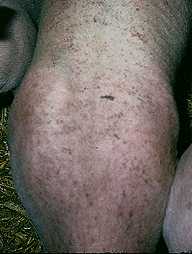 Acute mange: The skin is covered by minute red pimples.
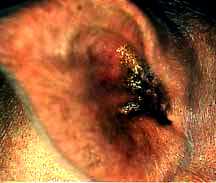 Thick crusty deposits in the ear
|
Clinical signs
Acute disease
The common signs are ear shaking and severe rubbing of the skin against the sides of the pen. Approximately three to eight weeks after initial infection the skin becomes sensitised to the mite protein and a severe allergy may develop with very tiny red pimples covering the whole of the skin. These cause intense irritation and rubbing to the point where bleeding may occur. Head shaking is a common symptom and hairs are often rubbed away leaving bare patches. The incubation period to the appearance of clinical signs is approximately three weeks although it may be several months before signs are noticed in large pig populations, particularly in feeder pigs housed in pens with solid partitions.
Chronic disease
After the acute phase thick asbestos-like lesions develop on the ear, along the sides of the neck, the elbows, the front parts of the hocks and along the top of the neck. (Fig.11-16).
Diagnosis
Persistent skin irritation with small red spots on the skin developing into asbestos-like thickening suggests the presence of disease. The skins of pigs can also be examined at slaughter for evidence of the small red pimples. Herds with active disease always show a high level of grade 2 or grade 3 lesions (Fig.11-17). Average grade scores at slaughter indicate the degree of infection and its economic significances. Diagnosis is confirmed by demonstrating the presence of the mite. To do this scrapings are taken from suspicious lesions on the skin and particularly inside the ears. A teaspoon is an ideal instrument to scarify material from the interior of the ear. This material can be spread onto a piece of black paper and left for ten minutes. Mange mites which are rounded in shape and only 0.5mm in length may be just visible to the naked eye. However to positively identify the mite the scrapings should be submitted to a laboratory for microscopic examination.
Serology - The ELISA test is a very specific test for detecting antibodies to the mange mites with an 80% sensitivity in growing pigs but less in sows. Following an eradication programme the ELISA test can be used to confirm the success, however wait at least 12 weeks and test weaners of at least this age as sow antibody levels may persist for up to a year. The ELISA test is also of value in confirming mange free herds.
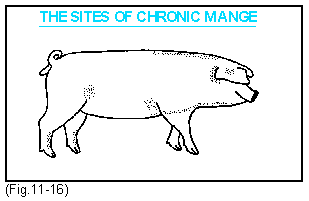
Average grade score of pigs examined at slaughter
- < 0.3 - Very low level, unlikely to be mange. Other factors such as fly bites can cause similar lesions.
- 0.5 - Disease well controlled no economic effect.
- 1 - 1.5 - Active disease, considerable irritation and rubbing.
- 2+ - Severe disease; expect losses of 0.1 in feed efficiency and 7-10 days extra to slaughter.
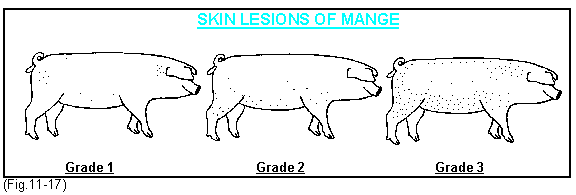
Similar diseases
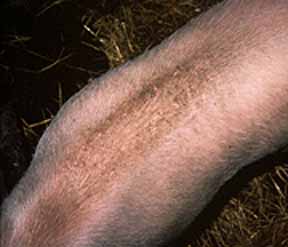 Hyperkeritinization; Note flakey skin, not to be confused with Mange |
Mange can be confused with the normal dead scurf of the skin (hyperkeratinization - see photo) that is often seen over the back and the neck but this flaky material can be rubbed away leaving normal skin beneath. The mange scabs on the other hand penetrate the skin surface, are not easily removed and skin damage is evident. Other diseases that might be confused with mange include greasy pig disease, swine pox and sun burn. Occasionally in mange free herds ear scrapings may reveal mite eggs and mites but no clinical disease. Such mites are indistinguishable from porcine Sarcoptes scabiei. This particularly occurs in pigs bedded on old straw that has been contaminated by other animals such as rats or birds with their own host specific mites. Such mites do not survive long or cause disease in the pig.
Economics
The economics of eradication are sound. The costs of the programmes are approximately the same as the amount of money spent on control over a 6-9 month period. The costs however are concentrated into a 4-6 week period.
Field experiences show that after eradicaiton sows are less restless with consequent reductions in piglet mortaltiy and increased weights at weaning. The most importatn effects however are in improvement to feed efficiency by up to 0.1 and in daily liveweight gain by 4 to 10% depending on severity.
Management control, treatment and prevention
- Mange is an expensive disease not only because of its economic effects on the pig but also the costs and necessity for repeated treatment. Medicines available are shown in Fig.11-18.

There are three aspects to consider:
1. Maintain a free herd
If the herd is mange free make sure purchased pigs are also free. Insist upon a veterinary declaration of the disease status. Examine incoming pigs carefully during their period of isolation. Take skin scrapings from suspicious lesions. Two injections of ivermectin, doramectin or related compounds ten days apart usually eliminates the mite but if in doubt keep the pigs out.2. Control the parasite
This can be can be carried out either by spraying, applying a oily liquid containing phosmet 20% to the back of the pig, (the medicine is absorbed through the skin) or by in-feed medication or injection. The objective of any control programme however must ultimately be to eliminate the parasite.Control programmes - These are based on the fact that the sows and boars in the breeding herd are the permanent reservoirs of infection, the growers and finishers being constantly removed to slaughter. The aim is to prevent the sucking sow infecting her piglets thereby producing potentially mange free animals. Such grower and finisher pigs are separated from skin contact with the breeding herd. Control or eradication programmes can be carried out either by injection of ivermectins which have a long period of activity, in-feed medicaion for 7 to 10 days or by topical application. The first two have given excellent results in the field.
The success of control programmes depends also on people and the following should be noted:
- Is there sufficient labour available to carry out the recommended programme?
- Is the correct equipment or methods of feeding sufficient?
- Can the correct dose levels be given?
- Carry out herd inspections to assess the level of disease particularly in sows and boars.
- Maintain the discipline of treating the sow seven days prior to farrowing. Set up a system of documentation.
Programme A
Adult stock
- Examine the breeding herd for the presence of chronic lesions. Identify such animals for special treatment. These chronic lesions, found especially in the ears behind the elbow and on the legs, can be difficult to eradicate and they remain a constant source of infection. If they are evident in the ears dress them three times, once every 10 days with either 1ml of phosmet or spray with 1% benzyl benzoate. If they are on the skin scrub with amitraz every 10 days.
- Treat all the breeding herd (gilts, sows and boars) with phosmet 20% 1ml to 10kg weight on one day. Repeat this 10-14 days later.
- Repeat this programme every three months. Alternatively, treat sows twice yearly but give them one single dose just prior to farrowing.
- Option 1 - Treat pigs on the day of weaning with 0.75 - 1ml of phosmet using a pump applicator or give an ivermectin injection.
- Option 2 - Medicate the creep feed with ivermectin for 7 days.
- Option 3 - Inject pigs at weaning with ivermectin or doramectin
- Treated pigs should only be moved into cleaned washed pens that have been sprayed with a parasecticide such as amitraz and left empty for at least three days, preferably five to six.
- If mange is active at the onset in the growing herd medicate with ivermectin in-feed for seven days.
- Treat all the sow herd with a single injection of ivermectin or doramectin and repeat every 6 months.
- Treat sows with phosmet seven days prior to farrowing.
- Treat weaners as in A.
- Inject boars every three months.
All breeding adult stock
- Medicate feed for seven days with ivermectin at a level of 100 mcg/kg liveweight.
- Repeat every six months. Round worms are also treated and controlled for the same cost.
- Treat sows with phosmet seven days prior to farrowing.
- Treat as in A.
3. Eradication
If the control programmes outlined above are carried out efficiently for a period of six months it becomes possible to eradicate mange mites because there will only be a low population present in the breeding herd. At the point where there is no clinical evidence of mange in the growing pigs or sows a final eradication in the sow herd should be carried out. There are two methods:1. Control first followed by eradication:
Control requires the production of mange free weaners by treatment post weaning and the movement of pigs to an all in all out system. This is much easier to carry out in the weaner producing herd than the breeder/finisher herd. Where practical segregation of treated weaners from potentially infected ones until their removal is ideal. See Segregated Disease Control in the health and disease data base.
- Carry out a control programme as described for 6 months.
- Purchase mange free breeding stock during this period.
- Examine the herd for signs of mange particularly chronic symptoms. Test scrape suspicious lesions. Listen for ear shaking in growing pigs. Cull any pigs with chronic lesions.
- Determine the management procedures for eradication i.e. segregated disease control and wean to slaughter depopulation or off site weaning and multi site production. SDC is the ideal for breeding finishing herds.
- Proceed as for eradication.
Whole herd eradication is expensive but effective. If however the breeding/grow/finsiher herd has problems with other diseases SDC is worth considering.
Weaned pigs are moved off site over an 8 week period whilst all infected weaners, growers and finishers are sold.
During the 6-8 weeek period sows and weaners are treated, sows for two 10 day periods with in-feed ivermecitin 10 days apart and weaners by in-feed medication for 7-10 days post weaing.
After removal of the infected weaners/growers buildings are cleaned and disinfected prior to reintroduction of the off site weaners.
The efficiency of eradication is further improved if early weaning and two or three site production is an option. Eradication in the combined breeding/finishing herd
- Only proceed when the disease is under control.
- Medicate all weaners and grow/finishing pigs with in-feed ivermectin as per manufacturers recommendations for 7 - 10 days. Note withdrawal periods.
- Inject all pigs at weaning with ivermectin or use in-feed medication for 14 days. Carry out for an 8 week period.
- Inject all sick pen pigs with ivermectin and continue in-feed medication for 14 days.
- Medicate all the breeding herd with in-feed ivermectin for 10 days twice 10 days apart.
- Move treated weaners only to totally cleaned and disinfected houses and pens. Spray pens with a topical ascaricide.
- Keep treated weaners separate from the grow/fiinisher herd. If this is not practical medicate in-feed the grow/finishers again 3 weeks later and continue the weaner medication for a 12 week period. Send all finishers to slaughter.
Once the programme has been completed wait at least seven months before success can be claimed. This is determined by the lack of any clinical evidence, the observations of finishing pigs at slaughter and regular scrapings of ears particularly of boars and finishing pigs.
If the eradication has failed the appearance of the allergic skin conditions can be sudden.
Management control and prevention
Summary
- Treat regularly to prevent a build up of numbers.
- Disease is less easily spread where sows are housed in individual confinement.
- Treat boars regularly every 2-3 months. They are a constant source of infection.
- The mite will only live away from the pig for around five days.
- The mite is host specific, except that on rare occasions pig attendants develop a localised lesion, and it is easily kept out of the herd.
- Always treat animals twice 10-15 days apart.
- Leave pens empty for three days after infected pigs move out and spray the pen after washing with a mange dressing.
- Treat pigs in the hospital pens regularly.
Links to other web pages
Below are some links to other web pages for further reading on Mange:
Click here to find out how IVOMEC can help treat mange in animals
Hog Mange - Plant and Soil Science Department, University of Vermont Extension.
External Parasite Control on Swine - Purdue University Cooperative Extension Service.
Swine mange mites: Their control and eradication - University of Nebraska-Lincoln Extension Service - NEB Guide
of internal and external parasites, including mange.









